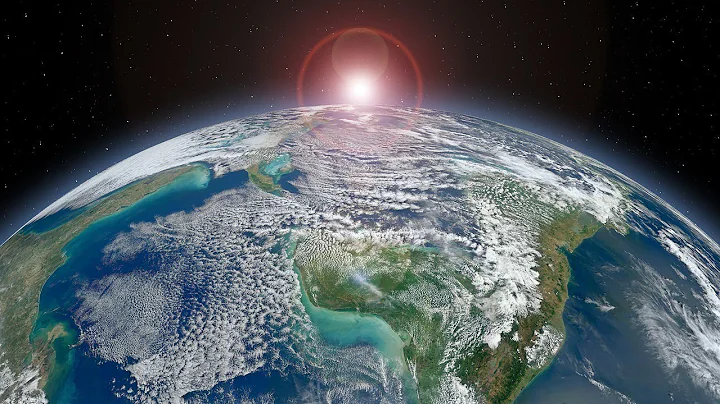The earth is the only place where land and sea life can thrive. Without the heat and light provided by the sun, without sufficient water sources, without the protection of the atmosphere, without rocks and minerals, without these foundations of the earth's ecosystem, life will eventually perish.
The Vibrant Earth
In our solar system, the Earth is the only planet where life can thrive. The third planet from Mercury, Earth is neither too close nor too far from the sun, allowing it to retain an outer atmosphere composed of oxygen and other gases and a surface water-rich lock up. These conditions give the Earth an insulating protective layer that allows life to thrive. In contrast, other planets in the solar system are either too hot or too cold to lack water and oxygen, so no life has been found.
The structure of the Earth is layered, with an extremely hot solid metal core in the center, surrounded by a molten outer core. The outer core is in turn surrounded by a thick, hot mantle, and the outermost layer is a cold, thin, brittle outer crust. The mantle is constantly being disturbed by energy from the core, which puts pressure on the crust, causing it to break into different "plates." Throughout geological time, the drift between plates has changed the geography and living environment of the earth. Landforms such as oceans and mountains are constantly being formed and destroyed, and various living organisms must adapt to these changes in the core.

The Structure of the Earth
The liquid mantle has been agitated by the heat from the earth's core, causing the plates of the outer crust to constantly move, causing earthquakes and volcanic eruptions on the surface.
The Sun and the Moon
The Sun and the Moon both have a direct impact on life on Earth. Without the energy of the sun, without its light and heat, there would be no life. Solar energy heats the atmosphere, oceans, and land, causing a wide variety of climates. Because the earth rotates at a certain angle and revolves around the sun, the sun's radiant energy will be transmitted unevenly to the earth's surface, resulting in daily, seasonal, and yearly changes in the living conditions of animals and plants such as light and heat. Even at the equator, there are temperature changes due to the alternation of day and night. The moon moves around the earth, and its gravity affects the tides in the oceans. Tidal cycles have a huge impact on coastal organisms, forcing them to adapt to changing living conditions.

Solar Flares
The sun's energy is strongly released from the surface through periodic explosions. The energy heats the solar atmosphere, forming hot ionized gases, that is, solar flares.
Fragile atmosphere
The thickness of Earth's atmosphere is about 120 kilometers. The atmosphere is divided into several layers, each with its own temperature and gas composition. The density decreases with height until the outermost layer becomes the thin ionized layer . The ozone layer is located at a lower level in the atmosphere. It can absorb ultraviolet radiation and other radiation that is harmful to living cells, and plays a very important role in protecting life on the earth. Before the ozone layer formed, life existed only in the oceans, because seawater also protects against some UV radiation.
Most water vapor and weather activity is confined to the troposphere, the bottom 16 kilometers of the atmosphere. The interaction between the earth's surface water and the atmosphere creates a water cycle: water enters the atmosphere from the earth's surface, and then returns to the land and ocean through clouds, rain and snow. Water flows from land back to the ocean, although significant amounts also return to lakes, glaciers or seep into the ground.

Blue Planet
2/3 of the earth's surface is covered with water, which ensures biological diversity.

Layering of the Atmosphere
The Earth is surrounded by a thick, layered atmosphere, which is composed of water vapor and various gases that captures solar energy and heats the surface.
A variety of rocks
There are about 500 different kinds of rocks on the earth, which are composed of thousands of natural mineral combinations. All rocks have specific compositions and properties and can be divided into three main types; igneous rocks , sedimentary rocks and metamorphic rocks . Igneous rocks were originally molten, sedimentary rocks were deposited on the Earth's surface, and metamorphic rocks are the products of alteration of rocks that previously existed within the Earth's crust.These different types of rocks are exposed at the surface due to a mixture of uplift driven by crustal movements and surface processes such as weathering and erosion. Erosion also changes rocks, creating different types of landforms, soils and sediments. These are the inorganic elements that living things depend on for their survival.

Igneous Rock
The cooling and solidification of molten rock produces crystallized igneous rock. They differ in composition and structure, with rapid cooling forming fine-grained rocks and slow cooling forming coarse-grained rocks.

Metamorphic Rocks
Heat and pressure applied to rocks deep below the earth's surface can change their form and mineral composition, forming metamorphic rocks such as slate, schist and marble.

Sedimentary rocks
Sand and dead animal bones continue to settle in layers on the seafloor and river beds. After hundreds of millions of years of burial, these sediments were eventually compacted and hardened into rocks under the gravity of subsequent sedimentary layers and the water above them.
These different types of rocks are exposed at the surface due to a mixture of uplift driven by crustal movements and surface processes such as weathering and erosion. Erosion also changes rocks, creating different types of landforms, soils and sediments. These are the inorganic elements that living things depend on for their survival.
Igneous Rock
The cooling and solidification of molten rock produces crystallized igneous rock. They differ in composition and structure, with rapid cooling forming fine-grained rocks and slow cooling forming coarse-grained rocks.

Metamorphic Rocks
Heat and pressure applied to rocks deep below the earth's surface can change their form and mineral composition, forming metamorphic rocks such as slate, schist and marble.

Sedimentary rocks
Sand and dead animal bones continue to settle in layers on the seafloor and river beds. After hundreds of millions of years of burial, these sediments were eventually compacted and hardened into rocks under the gravity of subsequent sedimentary layers and the water above them.





















